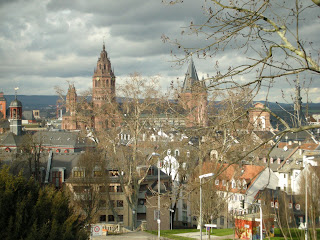
 I have to admit that this is by far the ugliest Rathaus (city hall) I have ever seen. A check online revealed that the Rathaus was acutally built between 1970 and 1974 by Danish architects using Swedish marble, which probably was like the Esplanade of the day, but thought by many as being not pleasant looking.
I have to admit that this is by far the ugliest Rathaus (city hall) I have ever seen. A check online revealed that the Rathaus was acutally built between 1970 and 1974 by Danish architects using Swedish marble, which probably was like the Esplanade of the day, but thought by many as being not pleasant looking.The Mainzer Dom (Mainz Cathedral)
The thousand year old Cathedral was built around the year 975. It was predominantly Romanesque in style. In front of the Cathedral stands a beautiful monument. Together with the cathedrals in Worms and Speyer (all of which I have been to), these are today the oldest in Germany.

 At the Cathedral is also the Marktplatz, here stands a row of tastefully decorated houses which resembled the Chinese version of shophouses.
At the Cathedral is also the Marktplatz, here stands a row of tastefully decorated houses which resembled the Chinese version of shophouses.  One of the alters inside the Cathedral
One of the alters inside the Cathedral There is a small garden which is enclosed by the Cathedral. Like most other churches, this garden is actually a burial ground for bishops of this Cathedral.
There is a small garden which is enclosed by the Cathedral. Like most other churches, this garden is actually a burial ground for bishops of this Cathedral. I found this statue to be really interesting. It shows a decapitated man holding his own head.
I found this statue to be really interesting. It shows a decapitated man holding his own head. Outside the cathedral. Notice that the flowers are starting to sprout in the spring season.
Outside the cathedral. Notice that the flowers are starting to sprout in the spring season. The Statue of Schiller.
The Statue of Schiller.Walk up to the Zitadelle (citadel)
A Citadel is like a fortress on elevated grounds used for the purpose of protecting the city. From the Schillerplatz, we walked up towards the Citadel in the hope of getting a panoramic view of the city. Along the way up we passed by this interesting windmill, which was in the past a windmill but today converted to a slide.

Most Germans that I spoke to regard Mainz to be a beautiful city. I would think that it is perhaps the presence of the Cathedal that gave the Innenstadt its touch. However if I would to compare to places like Heidelberg then perhaps Mainz does not stand out. One thing for sure, the bank along the river Rhine could have been better looking.




1 comment:
nice photos... take care bro... :)
Post a Comment